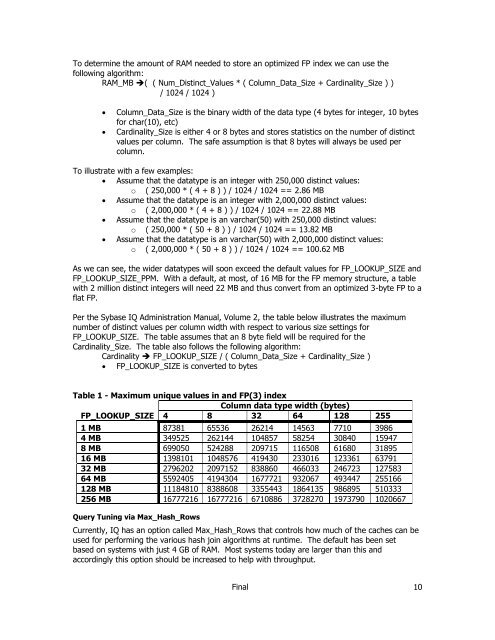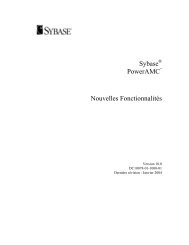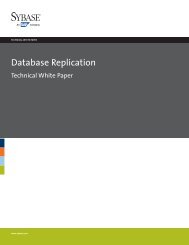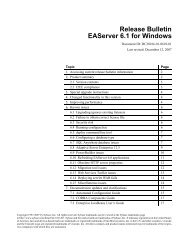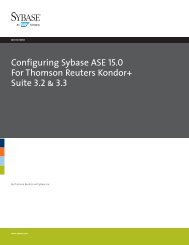A Practical Hardware Sizing Guide for Sybase IQ
A Practical Hardware Sizing Guide for Sybase IQ
A Practical Hardware Sizing Guide for Sybase IQ
You also want an ePaper? Increase the reach of your titles
YUMPU automatically turns print PDFs into web optimized ePapers that Google loves.
To determine the amount of RAM needed to store an optimized FP index we can use the<br />
following algorithm:<br />
RAM_MB �( ( Num_Distinct_Values * ( Column_Data_Size + Cardinality_Size ) )<br />
/ 1024 / 1024 )<br />
� Column_Data_Size is the binary width of the data type (4 bytes <strong>for</strong> integer, 10 bytes<br />
<strong>for</strong> char(10), etc)<br />
� Cardinality_Size is either 4 or 8 bytes and stores statistics on the number of distinct<br />
values per column. The safe assumption is that 8 bytes will always be used per<br />
column.<br />
To illustrate with a few examples:<br />
� Assume that the datatype is an integer with 250,000 distinct values:<br />
o ( 250,000 * ( 4 + 8 ) ) / 1024 / 1024 == 2.86 MB<br />
� Assume that the datatype is an integer with 2,000,000 distinct values:<br />
o ( 2,000,000 * ( 4 + 8 ) ) / 1024 / 1024 == 22.88 MB<br />
� Assume that the datatype is an varchar(50) with 250,000 distinct values:<br />
o ( 250,000 * ( 50 + 8 ) ) / 1024 / 1024 == 13.82 MB<br />
� Assume that the datatype is an varchar(50) with 2,000,000 distinct values:<br />
o ( 2,000,000 * ( 50 + 8 ) ) / 1024 / 1024 == 100.62 MB<br />
As we can see, the wider datatypes will soon exceed the default values <strong>for</strong> FP_LOOKUP_SIZE and<br />
FP_LOOKUP_SIZE_PPM. With a default, at most, of 16 MB <strong>for</strong> the FP memory structure, a table<br />
with 2 million distinct integers will need 22 MB and thus convert from an optimized 3-byte FP to a<br />
flat FP.<br />
Per the <strong>Sybase</strong> <strong>IQ</strong> Administration Manual, Volume 2, the table below illustrates the maximum<br />
number of distinct values per column width with respect to various size settings <strong>for</strong><br />
FP_LOOKUP_SIZE. The table assumes that an 8 byte field will be required <strong>for</strong> the<br />
Cardinality_Size. The table also follows the following algorithm:<br />
Cardinality � FP_LOOKUP_SIZE / ( Column_Data_Size + Cardinality_Size )<br />
� FP_LOOKUP_SIZE is converted to bytes<br />
Table 1 - Maximum unique values in and FP(3) index<br />
Column data type width (bytes)<br />
FP_LOOKUP_SIZE 4 8 32 64 128 255<br />
1 MB 87381 65536 26214 14563 7710 3986<br />
4 MB 349525 262144 104857 58254 30840 15947<br />
8 MB 699050 524288 209715 116508 61680 31895<br />
16 MB 1398101 1048576 419430 233016 123361 63791<br />
32 MB 2796202 2097152 838860 466033 246723 127583<br />
64 MB 5592405 4194304 1677721 932067 493447 255166<br />
128 MB 11184810 8388608 3355443 1864135 986895 510333<br />
256 MB 16777216 16777216 6710886 3728270 1973790 1020667<br />
Query Tuning via Max_Hash_Rows<br />
Currently, <strong>IQ</strong> has an option called Max_Hash_Rows that controls how much of the caches can be<br />
used <strong>for</strong> per<strong>for</strong>ming the various hash join algorithms at runtime. The default has been set<br />
based on systems with just 4 GB of RAM. Most systems today are larger than this and<br />
accordingly this option should be increased to help with throughput.<br />
Final<br />
10


